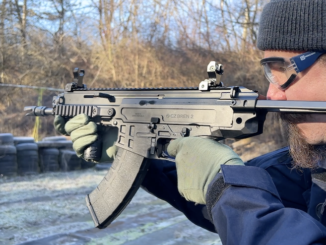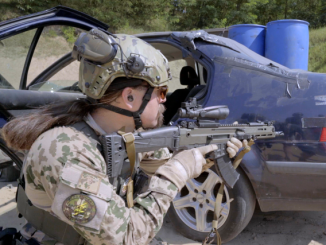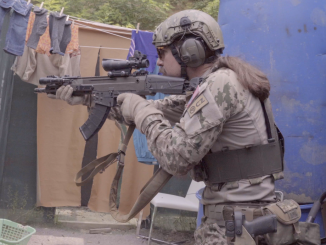The original Scorpion was adopted in .32 ACP caliber as the vz.61 by the Czechoslovakian military – but development of the Scorpion did not end there. Prototypes were also developed in .380, 9×18 Makarov, and 9x19mm. In particular, the 9x19mm version, designated vz.68, got as far as field trials with the Army. Unfortunately, its designer died, and impetus for the development program ended with him.
In the 1990s, however, the new Czech Republic was looking for a new military submachine gun, specifically in 9x19mm. The CZ company (now a private concern) looked around for what it might already have available, and found the vz.68. A further series of prototypes were made, now designated “Scorpion 9×19”. They were tested but rejected by the Czech military, and failed to get any foreign export sales. This is most likely because the 9mm Scorpion was a quite complex gun (as was the vz.61), and much more costly to produce that typical military submachine guns of the period – without providing much practical benefit over those cheaper designs. In total, only about 85 examples of 9x19mm Skorpions were made between the 1960s and 1990s. Instead, CZ would develop the Evo 3 for Czech military use.
Mechanically, the 9×19 versions of the Skorpion are basically unchanged from the original vz.61. The receiver has been stretched just slightly (about one inch) and the bolt mass approximately doubled. The same rate reducer is used, and the 9x19mm guns are still closed-bolt and hammer-fired with a simple blowback operating mechanism. Thanks to CZ for giving me access to these really neat prototypes from their factory reference collection! Make sure to check them out on Facebook and Instagram.




I’m declaring Czechoslovakia to be the France of the Eastern European gun world. They both have interesting weapon designs that impact the world at large even though their groundbreaking weapons find limited worldwide distribution.
Limited… Worldwide… Distribution…?
My friend, I think the words you’re using there are slightly inaccurate…
Czech weapons played a huge role in both pre-WWII armaments, WWII, and post-WWII. ZB-26 ring any bells? The BREN? Vz24 rifles? (admittedly, Mauser designs, but Czech-made ones… They were on the Kar98k path before the Germans were) The CZ-75 series of handguns?
Describing the Czech distribution as “limited” is so far off reality as to be risible. They’ve armed a considerable chunk of the world, both before WWII, and after.
I agree hole heartedly. He mis spoke that’s all.
Yeah, I agree. We Czechoslovakian used to export a lot of guns to many contries which wanted to defeat western occupants and colonizers. Not just Africa, South America and so on. Vietnam for example.
btw
I remember the elementar military drill with vz. 58 and scorpion: switch selector forward – 30 bullets to americans murders, switch down – peace, switch the selector backwards – you loose and you can send the one bullet to your head to avoid being captured by yankee who want to rape you.
“(…)Czechoslovakian used to export a lot of guns to many contries which wanted to defeat western occupants and colonizers.(…)”
What about OPERATION BALAK https://en.wikipedia.org/wiki/Operation_Balak
does it count as country which wanted to defeat western occupants and colonizers
Correct. And we can go to South America (weapons used during Chaco war), Iran (rifles and machineguns, but also locomotives), China (large part delivered thru J.Inglis, Canada), Yugoslavia (machineguns) and the list goes on. Not too far back the Czech national military museum recovered LT-35 tank from Peru. So much for that.
But, the truth is that Czech armament industry used the free market space vacated by post WW1 Germany to its success.
A suitable comparison to CZ would be Belgium: Both countries are small, but have a significant smallarms industry that played a major role in firearms history.
Both countries have a big industry in general compared to their small size on the worldmap. Anything machine building you find good products from both countries.
Of course firearms enthusiasts look at the bangsticks first.
Yes and both countries were fiercely competing against each other between the world wars.
And do not forget the 3rd Reich heavily used Czechoslovakian industrial resources.
Moreover both Belgium and Czechoslovakia were multipart in that there were different dominant languages in certain areas – français/vlaams and čeština/slovenčina respectively
“..have a big industry..”. I’d correct it slightly.
In case of CSR it is for most part a matter of past. For most part the Czech heavy and prime industries were ravaged in post-Berlin wall period. The current CZUB success is a rare exception.
“Prototypes were also developed in .380, 9×18 Makarov, and 9x19mm.(…)”
http://www.vhu.cz/exhibit/samopal-cz-skorpion-9-x-19/ claims said development was instigated by MZO (Ministry of Foreign Trade) hinting that this was supposed to be export weapon. Basic technical specs are given as follow
Caliber: 9 mm Parabellum
Overall length: 307 mm / 588 mm (stock closed/opened)
Height: 180 mm (sans magazine)
Width: 40,2 mm
Barrel length: 131,9 mm (sans muzzle device)
Capacity: 20
Mass: 2240 g (with empty 20-round magazine)
Magazine Wojskowy Przeglad Techniczny of Poland (hope I got that right because I only saw a German translation) as early as issue 9 of 1972 published a short summary about the four models:
vz 61 in 7.62 Browning, 1.30 kg, rof 750/minute
vz 64 in 9 mm short, 1.35 kg, rof 800/minute
vz 65 in 9 mm “Soviet”, 1.35 kg, rof 800/minute
vz 68 in 9 mm Parabellum, 2.03 kg, rof 750/minute
It also named the designer of the Scorpions: Miroslav RYBAR, who deceased in 1970 at the age of only 46.
Your names are missing diacritics
Wojskowy Przegląd Techniczny https://commons.wikimedia.org/wiki/Category:Illustrations_from_%22Wojskowy_Przegl%C4%85d_Techniczny%22
and
Miroslav Rybář https://encyklopedie.brna.cz/home-mmb/?acc=profil_osobnosti&load=25767
Daweo, thank you for adding the diacritics. The document I had was an old typoscript of a translation without diacritics.
his bio
https://encyklopedie.brna.cz/home-mmb/?acc=profil_osobnosti&load=25767
Ha! He managed Czech out the description text below…
If you are wondering how Czech vz. 61 sub-machine guns were checked see http://www.vhu.cz/samopal-vzor-61-armadni-technicky-magazin-c-11965/
Looks like the Skorpion 9×19 wire stock does in fact lock against the front sight wings. I don’t understand what Ian is saying about it locking against the muzzle device.
Having deja vu here.